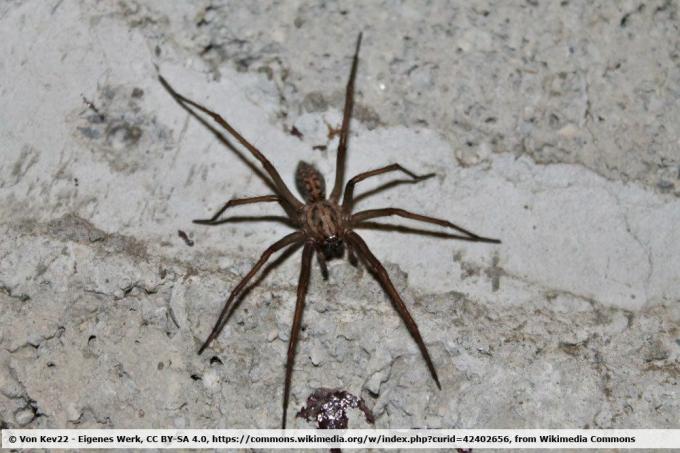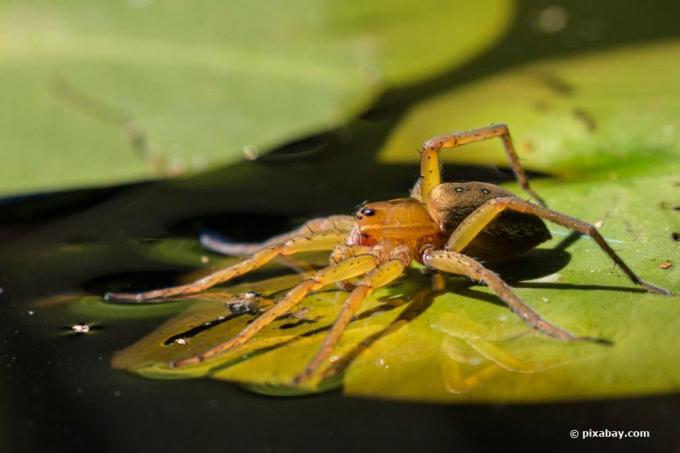
table of contents
- Spider bite in Germany
- risk groups
- Reasons for a bite
- 5 species of spiders in portrait
- 1. Nurse Dornfinger
- 2. Water spider
- 3. Garden spider
- 4. Zoropsis spinimana
- 5. Big angle spider
- Actions after a spider bite
For many people, spiders are the epitome of horror and horror. Due to the creepy appearance and the fact that all spiders produce venom and have fangs, the Araneae don't really have a good reputation. It is well known that the spider is much safer in Germany than in countries like Australia or Brazil. Nevertheless, many people wonder how dangerous a spider bite can really be at home and what measures are necessary afterwards.
Spider bite in Germany
The bite of a spider of any size is poisonous. But that doesn't mean that every spider venom has the potential to be dangerous for humans. There are also many taxa whose biting tools, the chelicerae, are not strong or large enough to pass through to penetrate the thick layers of human skin, which is the ideal protection against the eight-legged bogeymen is. Domestic spiders simply lack the "punch" and toxic potency to be really dangerous to adults, teenagers, and animals like dogs or cattle.
risk groups
However, the following creatures must be careful, as the skin and susceptibility to toxicity is significantly higher:
- Toddlers
- Babies and newborns
- People with thin, soft or sensitive skin
- Cats
- Small animals like hamsters or rabbits

In the case of seniors, it generally depends on the state of health whether a spider bite could be dangerous. However, even if your four week old baby is bitten by a native species, you don't really need to worry. The amounts of poison here are simply too small to cause lasting damage. The bite will be painful, but it does not pose any real danger. It becomes problematic if the wounds become infected, as spiders transport a large number of pathogens on your body and the claws of the jaw:
- bacteria
- Viruses
- mushrooms
If the spider just scratches the skin with its mouthparts, it can get into the wound and lead to an infection. These infections are often much worse than the poison itself and can even harm adult humans.
Reasons for a bite
The advantage: In Germany, a spider bite only occurs when the animal feels threatened or cannot escape. Typical situations are:
- Crushing of the spider, for example when supporting it with the hand
- Spider is deliberately cornered
- Spider gets stuck in clothes
The first scenario in particular is typical and children in particular are bitten this way when they act out their urge to research. None of the species native to Germany is really aggressive in contrast to species like that Australian Sydney funnel-web spider (Atrax robustus), even an approaching human attacked. As soon as you leave the spiders alone and do not squeeze them, they can even be carefully picked up via a stick and viewed.
There are a total of five species of spiders in the home, which can penetrate the skin with their jaw claws and inject poison. Only two of these are medically relevant.
tip: Spider bites, like bee or wasp stings, are much larger for those with insect venom allergies Danger and therefore you should always pay attention to whether there are allergic reactions after a bite comes. If this is the case, you should see a doctor as soon as possible and, if available, use appropriate pre-filled adrenaline syringes, which have an effective effect on the body.
5 species of spiders in portrait
As mentioned above, there are five species of spiders in Central Europe that can bite humans. Although all of these are poisonous, only two of them are medically relevant, i.e. associated with secondary symptoms for humans. All remaining spider species that you encounter in the home are completely safe for you, as their mouthparts cannot even penetrate the thin skin of a baby. The following is a list of the five "most dangerous" spider species in Germany and Central Europe:
1. Nurse Dornfinger
Cheiracanthium punctorium is considered to be the most poisonous species of spider in Central Europe and is present throughout orange-red body, long legs and large biting tools. The abdomen of the thorn finger is yellow-green, while the legs are yellow-brown in color. The spider with approx. 15 millimeter large, oval body occurs mainly from southern Germany to Frankfurt am Main and can be found in dry forest areas, on meadows and roadsides. The bite is poisonous and at the same time very painful, similar to a wasp sting. The following symptoms are possible after the bite:
- The bite is very burning and stinging
- Swelling of the bite site
- The bite resembles a bruise
- Vomit
- nausea
- headache
- chills
- increased body temperature
- in extreme cases circulatory collapse
2. Water spider
In slow flowing and clean still waters you can find Argyroneta aquatica, the water spider. This can also be recognized by the large mouthparts, the elongated body and the long legs, as well as by their habitat under the surface of the water. The spider bite is poisonous, but without any subsequent consequences for humans except for pain that is comparable to a wasp sting. The bite site may itch a little and redden. It is considered to be the second most dangerous spider in Germany because its chelicerae can penetrate all layers of the skin.
3. Garden spider
The genus Araneus is often found in gardens, orchards and forests and because of the Cross pattern Quickly recognizable on the back, especially in the thickened abdomen of the females, which are up to 18 millimeters in size. A cross spider bite is quite common, but completely harmless, because only thin areas of skin such as the hollow of the knee can be penetrated. Typical symptoms are pain like a bee sting, redness and itching.
4. Zoropsis spinimana
The Zoropsis spinimana migrated from the Mediterranean to southern Germany and is clearly recognizable due to its size of up to two centimeters. In addition, the entire body of the spider is hairy. With outstretched legs you can reach sizes of 5 cm. It also looks very long. A bite is like a weaker bee sting and besides the initial stinging and a little itching it is harmless. It is also often mistakenly referred to as the curled spider or curled spider. However, these terms are not officially established, as the term “curled spider” includes over 100 species.
5. Big angle spider
The large angle spider (Eratigena atrica) can also only penetrate the thinnest layers of skin and itching and burning persist for about half an hour. Otherwise, the bite is like a classic mosquito bite. The house angle spider is particularly noticeable because of its extremely long legs, which are monochrome. They also build Funnel nets in human dwellings in places that are rarely visited by humans.

As you can see, you don't really have to worry about permanent damage even with the well-known garden spider. Since many of the symptoms are similar to stings from other insects, you can recover from the bites in a short amount of time. It can be done faster with suitable measures to reduce the intensity of the toxic effects and to alleviate pain.
tip: Do not confuse weaving spiders with harvestmen (Opiliones), because these are completely harmless in comparison. Harvesters, also known as Grandpa Langbein, have neither biting tools that can get through can penetrate human skin, nor do poison glands and therefore pose no danger to you or your family represent.
Actions after a spider bite
After a spider's bite, there are special measures you can take to reduce the symptoms and speed up healing. These look like this:
- Find the bite site
- resembles mosquito or bee stings in size and appearance
- Thoroughly clean under cold running water
- this removes dirt particles and superficial poison residues
- disinfect if necessary
- Cool the bite site
- ice cubes or wrapped cooling pads are suitable for this
- alternatively, you can use cold, damp cloths
- place this on the bite site
- Change cloths over time
When the body has finally cooled down, you should find a remedy for it Anti-inflammatory use. This is particularly important because it ensures that the wound does not cause any further problems with an infection in the long term. Persistent itching is also weakened somewhat, which relieves the urge to scratch the bite site. From this point on, you must be careful not to infect the wound after all, as this can lead to health problems. You should watch out for the following symptoms:
- Bleeding
- weeping bite
- Inflammation
As soon as you notice any of these symptoms, you should see a doctor as soon as possible, who will take a closer look at the bite site. This is particularly important for people who are sensitive or have an immune deficiency. So stay on your guard.

tip: In most cases, bite wounds do not need to be disinfected, but should be done if, for example, you have been in dense forest areas. Spiders are wild animals and can always transmit pathogens, especially if the bite wound is large enough.




